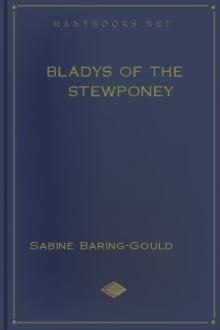The Book of Were-Wolves, Sabine Baring-Gould [best classic books TXT] 📗

- Author: Sabine Baring-Gould
Book online «The Book of Were-Wolves, Sabine Baring-Gould [best classic books TXT] 📗». Author Sabine Baring-Gould
If a female at midnight stretches between four sticks the membrane which envelopes the foal when it is brought forth, and creeps through it, naked, she will bear children without pain; but all the boys will be were-wolves, and all the girls maras. By day the were-wolf has the human form, though he may be known by the meeting of his eyebrows above the nose. At a certain time of the night he has the form of a dog on three legs. It is only when another person tells him that he is a were-wolf, or reproaches him with being such, that a man can be freed from the ban.
According to a Danish popular song, a hero transformed by his step-mother into a bear, fights with a knight:--
For 'tis she who bath bewitched me,
A woman false and fell,
Bound an iron girdle round me,
If thou can'st not break this belt,
Knight, I'll thee destroy!
* * * *
The noble made the Christian sign,
The girdle snapped, the bear was changed,
And see! he was a lusty knight,
His father's realm regained.
_Kjæmpeviser_, p. 147.
When an old bear in Ofodens Priestegjeld was killed, after it had caused the death of six men und sixty horses, it was found to be girded with a similar girdle.
In Schleswig and Holstein they say that if the were-wolf be thrice addressed by his baptismal name, he resumes his human form.
On a hot harvest day some reapers lay down in the field to take their noontide sleep, when one who could not sleep observed that the fellow next to him rose softly, and having girded himself with a strap, became a were-wolf.
A young man belonging to Jägerup returning late one night from Billund, was attacked, when near Jägerup, by three were-wolves, and would probably have been torn to pieces, had he not saved himself by leaping into a rye-field, for there they had no more power over him.
At Caseburg, on the isle of Usedom, a man and his wife were busy in the field making hay, when after some time the woman said to the man that she had no more peace, she could stay no longer, and went away. But she had previously desired her husband to promise, that if perchance a wild beast should come that way, he would cast his hat at it and then run away, and it would do him no injury. She had been gone but a short while, when a wolf came swimming across the Swine, and ran directly towards the haymakers. The man threw his hat at it, which the animal instantly tore to rags. But in the meantime a boy had run up with a pitchfork, and he dabbed the wolf from behind: in the same moment it became changed, and all saw that the boy had killed the man's wife.
Formerly there were individuals in the neighbourhood of Steina, who, by putting on a certain girdle, could transform themselves into were-wolves. A man of the neighbourhood, who had such a girdle, forgot one day when going out to lock it up, as was his wont. During his absence, his little son chanced to find it; he buckled it round him., and was instantaneously turned into an animal, to all outward appearance like a bundle of peat-straw, and he rolled about like an unwieldy bear. When those who were in the room perceived this, they hastened in search of the father, who was found in time to come and unbuckle the belt, before the child had done any mischief. The boy afterwards said, that when he had put on the girdle, he was seized with such a raging hunger, that he was ready to tear in pieces and devour all that came in his way.
The girdle is supposed to be made of human skin, and to be three finger-breadths wide.
In East Friesland, it is believed, when seven girls succeed each other in one family, that among them one is of necessity a were-wolf, so that youths are slow in seeking one of seven sisters in marriage.
According to a curious Lithuanian story related by Schleicher in his _Litauische Märchen_, a person who is a were-wolf or bear has to remain kneeling in one spot for one hundred years before he can hope to obtain release from his bestial form.
In the Netherlands they relate the following tale:--A man had once gone out with his bow to attend a shooting match at Rousse, but when about half way to the place, he saw on a sudden, a large wolf spring from a thicket, and rush towards a young girl, who was sitting in a meadow by the roadside watching cows. The man did not long hesitate, but quickly drawing forth an arrow, took aim, and luckily hit the wolf in the right side, so that the arrow remained sticking in the wound, and the animal fled howling to the wood.
On the following day he heard that a serving-man of the burgomaster's household lay at the point of death, in consequence of having been shot in the right side, on the preceding day. This so excited the archer's curiosity, that he went to the wounded man, and requested to see the arrow. He recognized it immediately as one of his own. Then, having desired all present to leave the room, he persuaded the man to confess that he was a were-wolf and that he had devoured little children. On the following day he died.
Among the Bulgarians and Sloyakians the were-wolf is called _vrkolak_, a name resembling that given it by the modern Greeks {Greek _brúkolakas_}. The Greek were-wolf is closely related to the vampire. The lycanthropist falls into a cataleptic trance, during which his soul leaves his body, enters that of a wolf and ravens for blood. On the return of the soul, the body is exhausted and aches as though it had been put through violent exercise. After death lycanthropists become vampires. They are believed to frequent battlefields in wolf or hyæna shapes, and to suck the breath from dying soldiers, or to enter houses and steal the infants from their cradles. Modern Greeks call any savage-looking man, with dark complexion, and with distorted, misshapen limbs, a {Greek _brúkolakas_}, and suppose him to be invested with power of running in wolf-form.
The Serbs connect the vampire and the were-wolf together, and call them by one name _vlkoslak_. These rage chiefly in the depths of winter: they hold their annual gatherings, and at them divest themselves of their wolf-skins, which they hang on the trees around them. If any one succeeds in obtaining the skin and burning it, the vlkoslak is thenceforth disenchanted.
The power to become a were-wolf is obtained by drinking the water which settles in a foot-print left in clay by a wolf.
Among the White Russians the _wawkalak_ is a man who has incurred the wrath of the devil, and the evil one punishes him by transforming him into a wolf and sending him among his relations, who recognize him and feed him well. He is a most amiably disposed were-wolf, for he does no mischief, and testifies his affection for his kindred by licking their hands. He cannot, however, remain long in any place, but is driven from house to house, and from hamlet to hamlet, by an irresistible passion for change of scene. This is an ugly superstition, for it sets a premium on standing well with the evil one.
The Sloyakians merrily term a drunkard a vlkodlak, because, forsooth, he makes a beast of himself. A Slovakian household were-wolf tale closes this chapter.
The Poles have their were-wolves, which rage twice in the year--at Christmas and at midsummer.
According to a Polish story, if a witch lays a girdle of human skin on the threshold of a house in which a marriage is being celebrated, the bride and bridegroom, and bridesmaids and groomsmen, should they step across it, are transformed into wolves. After three years, however, the witch will cover them with skins with the hair. turned outward; immediately they will recover their natural form. On one occasion, a witch cast a skin of too scanty dimensions over the bridegroom, so that his tail was left uncovered: he resumed his human form, but retained his lupine caudal appendage {_i.e. tail--jbh_}.
The Russians call the were-wolf _oborot_, which signifies "one transformed." The following receipt is given by them for becoming one.
"He who desires to become an oborot, let him seek in the forest a hewn-down tree; let him stab it with a small copper knife, and walk round the tree, repeating the following incantation:--
On the sea, on the ocean, on the island, on Bujan,
On the empty pasture gleams the moon, on an ashstock lying
In a green wood, in a gloomy vale.
Toward the stock wandereth a shaggy wolf.
Horned cattle seeking for his sharp white fangs;
But the wolf enters not the forest,
But the wolf dives not into the shadowy vale,
Moon, moon, gold-horned moon,
Cheek the flight of bullets, blunt the hunters' knives,
Break the shepherds' cudgels,
Cast wild fear upon all cattle,
On men, on all creeping things,
That they may not catch the grey wolf,
That they may not rend his warm skin
My word is binding, more binding than sleep,
More binding than the promise of a hero!
"Then he springs thrice over the tree and runs into the forest, transformed into a wolf." [1]
[1. SACHAROW: _Inland_, 1838, No. 17.]
In the ancient Bohemian Lexicon of Vacerad (A. D. 1202) the were-wolf is called vilkodlak, and is explained as faunus. Safarik says under that head,-
"Incubi sepe improbi existunt mulieribus, et earum peragunt concubitum, quos demones Galli _dusios_ nuncupant." And in another place: "Vilkodlaci, incubi, sive invidi, ab inviando passim cum animalibus, unde et incubi dicuntur ab incubando homines, i. e. stuprando, quos Romani faunos ficarios dicunt."
That the same belief in lycanthropy exists in Armenia is evident from the following story told by Haxthausen, in his _Trans-Caucasia_ (Leipzig, i. 322):--"A man once saw a wolf, which had carried off a child, dash past him. He pursued it hastily, but was unable to overtake it. At last he came upon the hands and feet of a child, and a little further on he found a cave, in which lay a wolf-skin. This he cast into a fire, and immediately a woman appeared, who howled and tried to rescue the skin from the flames. The man, however, resisted, and, as soon as the hide was consumed, the woman had vanished in the smoke."
In India, on account of the prevalence of the doctrine of metempsychosis, the belief in transformation is widely diffused. Traces of genuine lycanthropy are abundant in all regions whither Buddism has reached. In Ceylon, in Thibet, and in China, we find it still forming a portion of the national creed.
In the Pantschatantra is a story of an enchanted Brahmin's son, who by day was a serpent, by night a man.
Vikramâditya's father, the son of Indra, was condemned to be an ass by day and a man by night.
A modern Indian tale is





Comments (0)